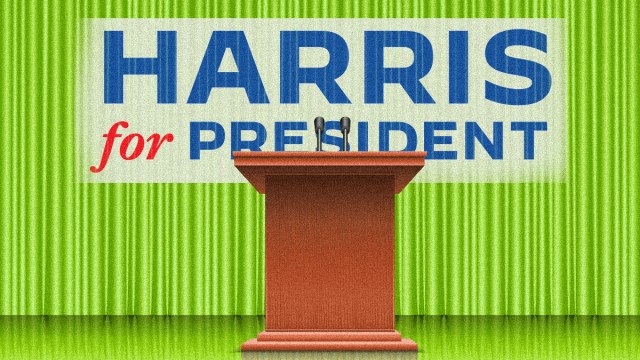The ‘Election as Entertainment’ Approach Is Engaging But Risky
Don’t miss Mediaweek, October 29-30 in New York City. Save 20% on passes and gain winning media strategies to drive growth across channels. Hurry—sale ends Sept 9.
The U.S. election charges full steam ahead now that both conventions are over, as “We the People” anxiously count down to Nov. 5 to determine the fate of our Union.
Simultaneously, it is becoming a masterclass in marketing.
While political campaigns have long utilized data-driven targeting and sophisticated marketing techniques (as seen with Cambridge Analytica’s controversial involvement in 2016), the 2024 election cycle takes these strategies to new heights, reflecting advancements in technology and a changing media landscape.
Always on, always ready
The sheer scale and speed with which campaigns can adjust their strategies in real-time is unprecedented. For instance, machine learning helps identify which messages resonate most across different voter segments, allowing for near-instant optimization.
The 2024 election cycle has also introduced a more pervasive “always-on” digital presence, creating a rhythm of constant engagement akin to entertainment media. Kamala Harris’ campaign has embraced this with a steady stream of digital content on TikTok and Instagram that feels less like traditional political ads and more like cultural commentary, making politics a continuous conversation.
However, this strategy has drawn criticism for sometimes feeling overly curated and lacking the authenticity that younger voters crave, leading to some disconnection with her messaging. In contrast, former President Donald Trump’s campaign has been praised for leveraging influencers who resonate more effectively with their base, although it, too, has faced scrutiny for pushing polarizing messages that risk alienating broader audiences.
This constant flow of content reflects the challenge for brands today: maintaining relevance in a 24/7 digital world. Brands, much like political campaigns, must strive for sustained engagement while ensuring authenticity to remain top-of-mind for their audiences.
Personalization and the risk of isolation
While there are valuable lessons to be gleaned from this election cycle, not all tactics translate directly into best practices for marketers. The “election as entertainment” approach has certainly kept voters engaged, but it also runs the risk of oversaturation, causing the audience to tune out or become fatigued.
Similarly, the use of hypertargeted messaging can lead to fragmentation, with campaigns speaking so specifically to certain groups that they fail to deliver a coherent, unifying message. Trump’s success with rural voters is a case in point; his highly targeted messaging resonates strongly with his base, but his overreliance on divisive rhetoric risks alienating moderate or undecided voters. Marketers need to strike a careful balance between personalization and maintaining a consistent brand identity.
Digital marketing has, without question, become the epicenter of both political campaigns and modern marketing strategies. However, this shift has not come without its pitfalls.
While artificial intelligence and data-driven personalization can optimize engagement, they also raise concerns about privacy and the ethical use of data. The 2024 election cycle highlights the power of these tools but underscores the importance of transparency and trust in marketing efforts. Brands must be mindful of how their data practices are perceived and ensure that they maintain consumer trust while leveraging new technology.
Influencers can boost or break credibility
In this election cycle, we’ve also seen notable missteps in omnichannel strategies.
Some campaigns have struggled with message consistency across different platforms. Content designed for one platform (e.g., a 30-second TV ad) doesn’t always translate well to more dynamic social media environments, leading to disjointed messaging.
Harris’ campaign has effectively maintained a digital-first presence but has faced challenges in translating her TV and in-person messaging into shorter, more digestible formats for platforms like TikTok, contributing to some loss in impact. These gaps in execution remind marketers to ensure that their messaging is cohesive and adaptable across all channels.
Influencers have played a significant role in this election, partnering with campaigns to boost reach and credibility. However, influencer strategy is not without its challenges. Harris’ partnerships with influencers like popular TikTok personalities have been questioned for mismatches in tone and relevance, leading to accusations of inauthenticity, particularly after the incident with YouTube influencer Kai Cenat.
On the other hand, Trump’s campaign has successfully leveraged influencers with strong, loyal followings in key demographic groups, helping him connect more effectively with specific voter segments. This is a lesson brands must heed: Influencer partnerships can be powerful but require careful curation and authenticity. The key is ensuring that influencers align with your message and that partnerships come across as genuine rather than opportunistic.
A happy marriage of art and science
One of the most important lessons from the 2024 election is that marketing should prioritize strategy over short-term performance tactics. In recent years, many brands have leaned too heavily on performance marketing, sacrificing long-term strategy for immediate gains. This election cycle highlights the importance of a strong strategic foundation—one that emphasizes understanding the “who and why” over the “what and how.”
Effective political campaigns, like those of Harris and Trump, succeed when they balance tactical execution with a clear and compelling overarching strategy. Brands should focus on building distinctiveness and how they uniquely meet the needs of their target audience, rather than simply flooding the market with performance-driven ads.
Ultimately, the election serves as a reminder that marketing is both an art and a science. It requires creativity and intuition, backed by data and technology, to build meaningful connections with audiences. As we look ahead, the lessons from this election cycle will undoubtedly shape how brands approach their marketing strategies in an increasingly complex and competitive landscape.
For marketers, protecting the time to focus on strategy and building capabilities for the future is essential. With the rapid evolution of technology, particularly AI, brands can automate more transactional work and free up time for strategic thinking. Those who manage to strike the right balance between tactical wins and long-term strategy will emerge as the true winners in this new landscape.
https://www.adweek.com/media/the-election-as-entertainment-approach-is-engaging-but-risky/

